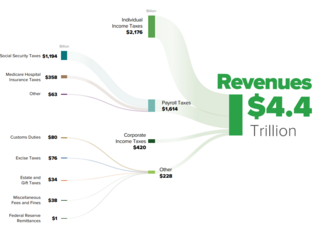
The United States has separate federal, state, and local governments with taxes imposed at each of these levels. Taxes are levied on income, payroll, property, sales, capital gains, dividends, imports, estates and gifts, as well as various fees. In 2020, taxes collected by federal, state, and local governments amounted to 25.5% of GDP, below the OECD average of 33.5% of GDP.
In the United States, a 401(k) plan is an employer-sponsored, defined-contribution, personal pension (savings) account, as defined in subsection 401(k) of the U.S. Internal Revenue Code. Periodic employee contributions come directly out of their paychecks, and may be matched by the employer. This pre-tax option is what makes 401(k) plans attractive to employees, and many employers offer this option to their (full-time) workers. 401(k) payable is a general ledger account that contains the amount of 401(k) plan pension payments that an employer has an obligation to remit to a pension plan administrator. This account is classified as a payroll liability, since the amount owed should be paid within one year.

In the United States, a conservation easement is a power invested in a qualified land conservation organization called a "land trust", or a governmental entity to constrain, as to a specified land area, the exercise of rights otherwise held by a landowner so as to achieve certain conservation purposes. It is an interest in real property established by agreement between a landowner and land trust or unit of government. The conservation easement "runs with the land", meaning it is applicable to both present and future owners of the land. The grant of conservation easement, as with any real property interest, is part of the chain of title for the property and is normally recorded in local land records.

A charitable trust is an irrevocable trust established for charitable purposes. In some jurisdictions, it is a more specific term than "charitable organization". A charitable trust enjoys varying degrees of tax benefits in most countries and also generates goodwill. Some important terminology in charitable trusts includes the term "corpus", referring to the assets with which the trust is funded, and the term "donor," which is the person donating assets to a charity.

The Federal Old-Age and Survivors Insurance Trust Fund and Federal Disability Insurance Trust Fund are trust funds that provide for payment of Social Security benefits administered by the United States Social Security Administration.

A donation is a gift for charity, humanitarian aid, or to benefit a cause. A donation may take various forms, including money, alms, services, or goods such as clothing, toys, food, or vehicles. A donation may satisfy medical needs such as blood or organs for transplant.
Car donation is the practice of giving away unwanted used automobiles or other vehicles to charitable organizations. In the United States, these donations can provide a tax benefit to the donor.
Tax advantage refers to the economic bonus which applies to certain accounts or investments that are, by statute, tax-reduced, tax-deferred, or tax-free. Examples of tax-advantaged accounts and investments include retirement plans, education savings accounts, medical savings accounts, and government bonds. Governments establish tax advantages to encourage private individuals to contribute money when it is considered to be in the public interest.

A charitable organization or charity is an organization whose primary objectives are philanthropy and social well-being.
In the United States, a donor-advised fund is a charitable giving vehicle administered by a public charity created to manage charitable donations on behalf of organizations, families, or individuals. To participate in a donor-advised fund, a donating individual or organization opens an account in the fund and deposits cash, securities, or other financial instruments. They surrender ownership of anything they put in the fund, but retain advisory privileges over how their account is invested, and how it distributes money to charities.
Planned giving is an area of fundraising that refers to several specific gift types that can be funded with cash, equity, or property. These gift vehicles are commonly based on United States tax law, but Canada, the United Kingdom, and other nations are beginning to establish similar laws. In the United States the specific rules of planned giving are defined by the United States Congress and the Internal Revenue Service.
A charitable gift annuity is a gift vehicle that falls into the category of planned giving. It involves a contract between a donor and a charity, whereby the donor transfers assets, such as cash or securities, to the charity in exchange for a partial tax deduction and a lifetime stream of periodic income from the charity. When the donor dies, the charity keeps the remaining assets.
A 501(c)(3) organization is a United States corporation, trust, unincorporated association or other type of organization exempt from federal income tax under section 501(c)(3) of Title 26 of the United States Code. It is one of the 29 types of 501(c) nonprofit organizations in the US.
A donor managed investment account is a charitable giving mechanism in which donors receive a full tax deduction at the time they fund the DMI account, but retain investment management rights over the account, and can request donations from the account to charities.
The United States Internal Revenue Service (IRS) uses forms for taxpayers and tax-exempt organizations to report financial information, such as to report income, calculate taxes to be paid to the federal government, and disclose other information as required by the Internal Revenue Code (IRC). There are over 800 various forms and schedules. Other tax forms in the United States are filed with state and local governments.

A supporting organization, in the United States, is a public charity that operates under the U.S. Internal Revenue Code in 26 USCA 509(a)(3). A supporting organization either makes grants to, or performs the operations of, a public charity similar to a private foundation.
A charitable remainder unitrust is an irrevocable trust created under the authority of the United States Internal Revenue Code § 664 ("Code"). This special, irrevocable trust has two primary characteristics: (1) Once established, the CRUT distributes a fixed percentage of the value of its assets to a non-charitable beneficiary ; and (2) At the expiration of a specified time, the remaining balance of the CRUT's assets is distributed to charity. The trustee determines the fair market value of the CRUT's assets at the time of contribution and thereafter on the applicable valuation date. The fixed annuity percentage must be at least 5% and no more than 50% of the fair market value of the assets in the corpus. The remainder must be at least 10% of the fair market value of the assets contributed to the CRUT. Code Section 664(d)(1) sets the federal income tax requirements for a charitable remainder unitrust.
A foundation in the United States is a type of charitable organization. However, the Internal Revenue Code distinguishes between private foundations and public charities. Private foundations have more restrictions and fewer tax benefits than public charities like community foundations.
The National Pension System (NPS) is a defined-contribution pension system in India regulated by the Pension Fund Regulatory and Development Authority (PFRDA) which is under the jurisdiction of the Ministry of Finance of the Government of India. National Pension System Trust was established by PFRDA as per the provisions of the Indian Trusts Act of 1882 to take care of the assets and funds under this scheme for the best interest of the subscriber.
National Philanthropic Trust (NPT) is an American independent public charity that provides philanthropic expertise to donors, foundations and financial institutions. NPT ranks among the largest grantmaking institutions in the United States.







